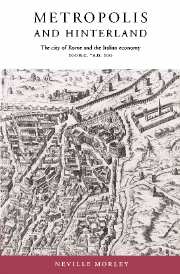Book contents
- Frontmatter
- Contents
- List of maps and figures
- Preface
- List of abbreviations
- Introduction: Rome and Italy
- 1 The metropolitan city in a pre-industrial economy
- 2 The demographic burden
- 3 A model of agricultural change
- 4 The transformation of the Roman suburbium
- 5 Agricultural development in central Italy
- 6 Exploiting the margins
- 7 Marketing and urbanisation
- Conclusion
- Bibliography
- Index
3 - A model of agricultural change
Published online by Cambridge University Press: 17 August 2009
- Frontmatter
- Contents
- List of maps and figures
- Preface
- List of abbreviations
- Introduction: Rome and Italy
- 1 The metropolitan city in a pre-industrial economy
- 2 The demographic burden
- 3 A model of agricultural change
- 4 The transformation of the Roman suburbium
- 5 Agricultural development in central Italy
- 6 Exploiting the margins
- 7 Marketing and urbanisation
- Conclusion
- Bibliography
- Index
Summary
Demand and supply
The dramatic growth of the population of Rome was impossible without an equally dramatic increase in the city's food supply. In part, this was achieved through state action. The political imperative to feed the urban plebs led magistrates and emperors to intervene in the grain supply, buying additional supplies in times of shortage and distributing grain collected as tax at a reduced price or without charge. The system of the annona became increasingly sophisticated, with the appointment of a praefectus annonae and incentives offered to shipowners to supply the city. The state may also have attempted at times to manipulate the market, by releasing quantities of state grain or by withholding it to drive prices up, but it was not in the administration's interests to antagonise the private traders who made an equally important contribution to the city's food supply.
State action alone was insufficient to keep the metropolis fed; a sizeable proportion of the city's demands for grain was met through the free market. Moreover, until the annona was expanded to include oil (at the turn of the second century A.D.) and wine and pork (in the 270s), Rome's supplies of all other foodstuffs were brought in through private channels. The elite may have fed their households from the produce of their own estates; the majority of the urban population had no option but to rely on the vagaries of the market.
- Type
- Chapter
- Information
- Metropolis and HinterlandThe City of Rome and the Italian Economy, 200 BC–AD 200, pp. 55 - 82Publisher: Cambridge University PressPrint publication year: 1996

